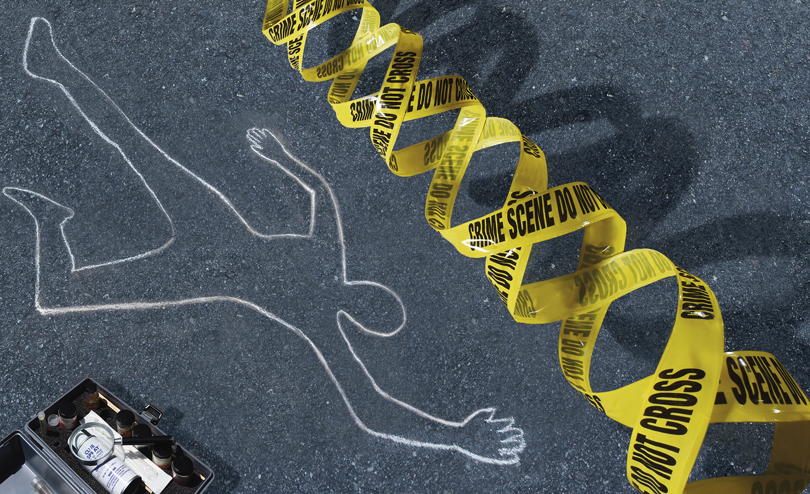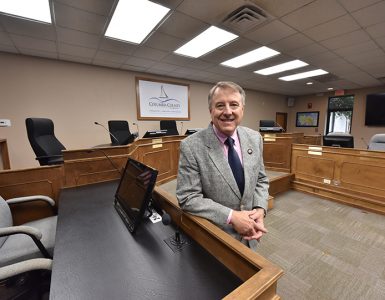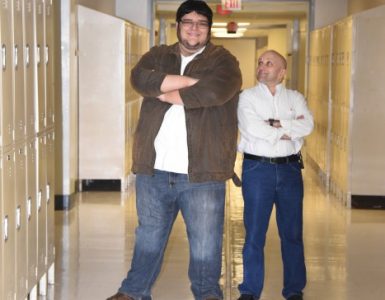Putting forensic science under the scope
So I’m sitting in the office of Dr. Candace Griffith, assistant professor in the Department of Sociology, Criminal Justice, and Social Work, and we’re talking about the use and accuracy of DNA evidence in criminal investigations. As someone who was fascinated by the criminal justice system long before she pursued it academically, this conversation is right in her wheelhouse, the intersection of her professional expertise, her interest, and, because of the prevalence of criminal justice podcasts and documentaries and crime shows on TV, much of contemporary entertainment.
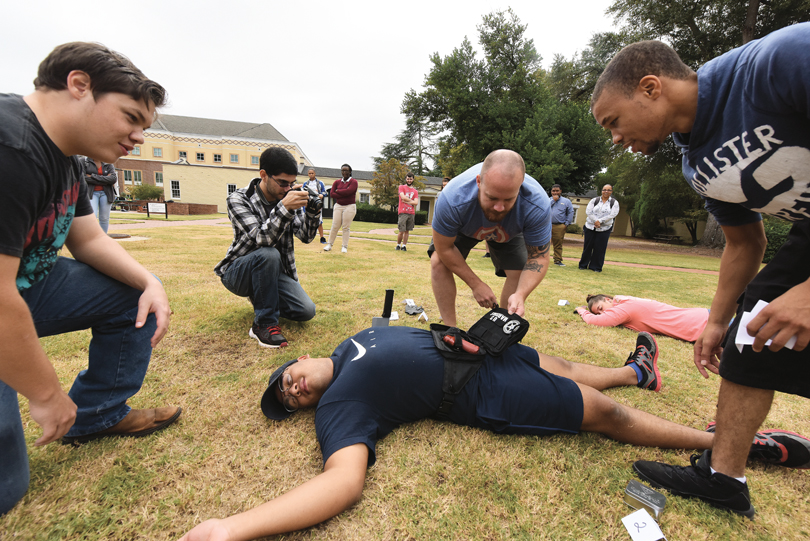
DNA’s use as a forensic tool goes back 30 years, but in the last decade or so it has achieved an almost mythical status as an absolute and unfailing barometer of innocence and guilt. If the scales of justice represent the legal system, more often than not, it seems like the double helix is the thing tipping them.
While its use is widespread and its accuracy is tough to argue, Griffith is trying to explain how it’s not always the magic bullet it’s portrayed to be. We’re getting bogged down in the theoretical, however, so I opt to change tactics.
“Okay,” I start, shifting a tad uncomfortably in my chair at this new direction. “Say you get murdered later today…”
Instead of flinching, she leans forward, her eyes wide.
“I’m one step ahead of you,” she says.
DNA (deoxyribonucleic acid) is a molecule that carries the genetic instructions of a living organism. Often called the building block of life, the information in DNA is like a blueprint of what we are and a genetic fingerprint of who we are. Simply put, DNA is what makes us different from other living things and me different from you.
It was first used in a forensic sense in England in 1986. A year later, the circuit court in Orange County, Florida, convicted a man of rape when the DNA from a blood sample matched the DNA in a semen sample taken from the victim.
Since then, DNA has grown more and more central to criminal investigations and the legal system’s handling of criminal cases. Along the way, it’s claimed a starring role in popular crime dramas like CSI and NCIS, where the scientists are celebrated alongside the investigators who used to get all the glory.
But if it’s so accurate, why do we end up with so much ambiguity when it comes to convictions? Why does it seem like we’re always hearing about killers going free or innocent people getting convicted?
Those questions bring us back to me and the manufactured murder of Candace Griffith.
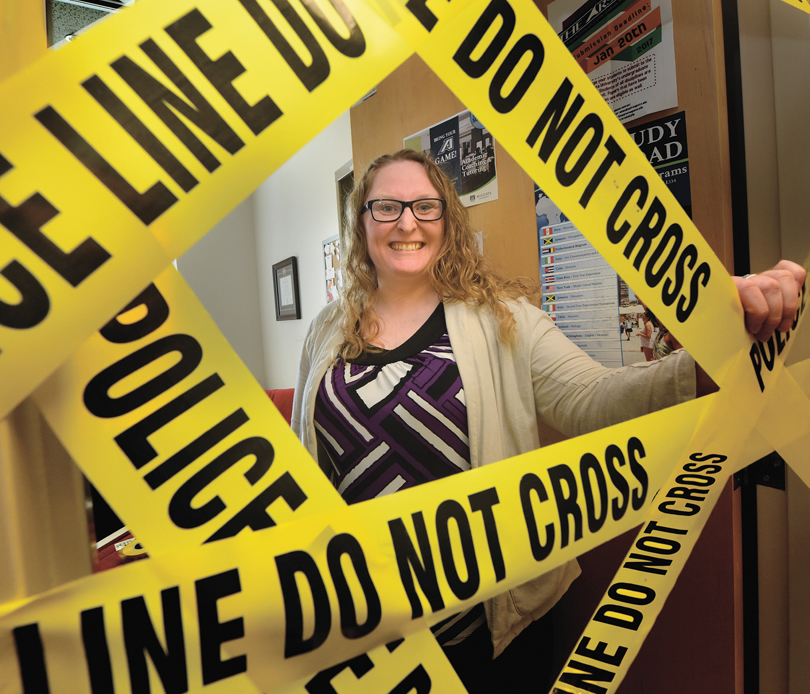
“So let’s look at what’s already happened,” she says, sounding as much like a detective as a professor. “That water bottle you brought in with you — the one you tossed into my trash can when you arrived — is crawling with your DNA. You’ve also undoubtedly shed some skin cells on the arm of the chair you’re sitting on, and I’m sure when you took off your jacket, you dropped a hair or two.”
I nod. I don’t need to be reminded of my thinning hair.
“All that’s your DNA positively establishing your presence here in my office,” she says. “Of course, it doesn’t necessarily mean you were here today, right before my murder, but the colleague who dropped off the Frosty? The one who popped in a few minutes ago? She will be able to confirm your presence this afternoon.”
“And you’ve also got my email requesting this meeting,” I add, pointing at her computer.
“Right,” she says. “And our earlier laughing? In the context of my murder, it would be easy for people to look back and mistake that as arguing or yelling.”
The building case against me gives me pause. I’ve always felt that if we live a certain kind of life, mind our Ps and Qs and generally stay out of trouble, we build up the capital to defend against something like this; not karma so much as a definable, documented sense of being a “good person.” Sure, there might be a speeding ticket in our past or an underage drinking violation from our college days, but our general goodness is there for everybody to see, not in what’s on the record, but in what’s not.
“Still,” I try to counter. “Maybe my DNA is here in your office, but after this, I’m going back to my office and then home. I’m not going to kill you, so my DNA won’t be found on your body.”
“True,” she says. “But just as the DNA evidence here doesn’t make you guilty, the absence of DNA evidence on my body doesn’t make you innocent.”
Sitting back in my chair, I’m not sure if I find that comforting or frightening. But I do think twice about running my hand through my hair.

“A crime scene is an interesting place,” says Dr. Joseph White.
Currently a faculty member at the Medical College of Georgia with half his time dedicated to surgical pathology signout and the other half as director of the autopsy service, White logged five years as a forensic pathologist with the Utah State Medical Examiner’s Office, where his days were filled with autopsies and death investigations.
When it comes to the real-life forensic use of DNA, White’s experience is tough to beat.
The crime scene he describes sounds like orchestrated chaos — lots of people from lots of offices doing lots of things simultaneously. Law enforcement has jurisdiction over the crime scene; the coroner or medical examiner has jurisdiction over the body.
In some states, like Utah, medical examiners have the authority under state law to investigate deaths and to perform autopsies without family permission. In other states, like Georgia, the legal authority resides with the coroner, who is a county-level elected official.
“In cases of homicide, you’ll spend a lot of time examining the body carefully for trace evidence of things like hair and fibers or possible sources of DNA evidence,” White says. “The approach is very systematic.”
At the crime scene, the body is carefully moved onto a plastic sheet, wrapped up and then put in the body bag. The sheet keeps potential evidence from falling off and eventually becomes a piece of evidence itself. At the autopsy, the forensic pathologist starts by disturbing the body as little as possible, going layer by layer while taking the appropriate level of care at each step to be able to preserve or gather the information.
“Generally, the forensic pathologist collects specimens from the body, packages those, and then signs them over in the chain of custody to the police, who transport them to the lab to be analyzed,” White says.
Though the process may be systematic, what they’re working with is often anything but controlled.
“The samples we’re working with are not like the samples that we work with in a hospital,” he says. “They’re not pristine. The body may have been exposed to the elements, there could be decomposition, there could be a lot of things. Contaminated samples are basically just the standard.”
And then there’s the size of the samples. Sometimes, they’re small. Small like a few skin cells swabbed from a knife handle (or from the arm of a chair).
“A lot of times we do get great answers off of that, but the smaller the sample, the more likely you are going to go through the amplification process.”
You can amplify DNA from a single cell, White says, but the process can induce some errors in the DNA sequence.
“You start to build this background noise where you’ve got 99 copies that are all perfect, but one that’s not,” he says. “When you get a hundred million copies, now you’ve got a million copies that aren’t perfect, so when you run it through the sequencer, you’re going to see that million in the background. It can reduce the perfection of the DNA – suddenly, your absolute answer doesn’t look so absolute.”
That doesn’t mean so much when you’re trying to match a person to a DNA profile, like in a missing person case. Matching the DNA from the remains to the profile you’ve built from samples collected from a hairbrush or a toothbrush is pretty straightforward.
Things get murkier, White says, when you’re trying to pick someone out of a lineup. Say two guys get in a bar fight and the victim has DNA under his fingernails. The genetic code that gets spit out by the computer contains the code from both of those people. That’s more complicated, but still relatively routine.
“It gets to be a little like reading sheet music with two songs on the staff,” he says. “If you know what one of the songs is, you can just erase those notes and see what’s left. So if you’ve got this mess of notes and you take off ‘Happy Birthday’ and ‘Here Comes Santa Claus’ is what’s left, then you’re great. That’s how identifying an individual to a known sample is so easy, because you’ve got the sheet music for ‘Happy Birthday.’”
The problem comes if there were four people involved in a bar fight and one of the people ends up dead and nobody knows who else was involved in the fight. When you run what’s under the fingernails, there are four songs in there, so it becomes very difficult because they just lay on top of each other. Outside of the victim, you don’t have any other songs to remove from the staff.
“In that respect, they’re very much like fingerprints,” White says. “Fingerprints are great if you have one to compare with, but one fingerprint by itself is meaningless, just like one string of DNA is meaningless.”
However, he says, you can store all the information in a computer, and if 10 years later the person is arrested and gets his or her DNA taken, it goes into the system and you can close out a lot of old cases.
“DNA is a tremendously powerful tool, but it does have its limits, and sometimes that’s difficult to communicate to laypeople or jury members, because Hollywood sort of says DNA gives me a yes or a no and it’s perfect and never has any faults,” White says. “Sometimes you do have a perfect laboratory match, but within the context of the case, if there’s another explanation for how these persons were in contact, DNA doesn’t mean they killed that person. So even if you do have a perfect DNA answer, sometimes how that fits into the context of the whole case is where the critical point lies.”
Back in Griffith’s office, she’s talking context and it’s scaring me.
“Honestly, even if they found DNA evidence that wasn’t yours on my body, that still doesn’t ensure you wouldn’t be found guilty.”
She tells me about the Central Park 5, where five African-American and Hispanic youths were charged and convicted of the rape and attempted murder of a Central Park jogger, even though none of their DNA matched the DNA found on the victim.
“There was only one perpetrator and one victim, but they negated that,” she says. “They said, ‘We may not have got all of them, but we got some of them.’”
Years later, DNA and other evidence proved another man, a convicted rapist and murder named Matias Reyes, acted alone in the attack on the Central Park jogger. The men were released from prison and received a settlement for the wrongful conviction.
And then there’s the case in Brian Stevenson’s book Just Mercy, about a black man who was convicted of murdering a white woman despite the fact there were 20 eyewitnesses who could place him somewhere else at the time of the murder.
“So DNA should never be interpreted outside the context of the case, but sometimes it is,” I say.
Griffith nods. “What we have to be careful of is our confirmation bias,” she says. “Is this just confirming what we already know? Is it contradicting what we know so we push it aside? Using DNA requires an element of critical thought, which investigators sometimes have and sometimes don’t.”
I tell her that’s not very reassuring.
“Our justice system will never be blind because our justice system is created by and run by people,” she says. “And people have eyes.”
Get a behind-the-scenes look at how we created our cover illustration. See Behind the Scenes: Analyzing DNA.

